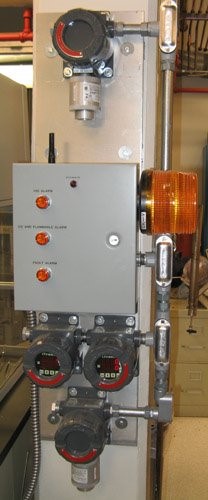Leak Detection
Hydrogen is colorless and odorless and therefore undetectable by normal human senses. So, personnel should use caution when approaching an area where there is the potential for a hydrogen leak. Best practices include:
- Listen for the sound of high-pressure gas escaping
- Listen and watch for alarms
- Use portable hydrogen detectors
- Check for small leaks by applying a soap bubble solution on the surface of areas where leaks are suspected
Instrumented hydrogen leak detection systems can be used to enhancing safety of the facility. Instrumented leak detection techniques include:
- Hydrogen (or flammable gas) detectors installed where leaking hydrogen is likely to concentrate
- Monitoring piping pressures or flow rates changes
- Locating hydrogen piping within another pipe (double containment) and monitoring the annulus for leaks
Detectors should be permanently installed in indoor facilities.
- Use listed or approved devices
- Locate detectors where leaking hydrogen will be accumulate such as:
- Stagnation points near the ceiling where hydrogen can accumulate
- Low-velocity regions of enclosure ventilation system
- Provide access to detectors for periodic calibration
- The sensitivity of the detector to other gases and vapors should be considered in the selection of the detector and should be explained to personnel
- Caution should be exercised when selecting and using detectors that may themselves be ignition sources.
- Alarms are normally set at 1% hydrogen by volume (25% of the lower flammability limit)
- The alarm should continue until manually reset even if the detected concentration drops below the alarm level
Instrumented leak detection systems should be integrated into the control systems such that they:
- Provide for automatic shut-off and isolation of hydrogen sources
- Shut down/deactivate/deenergize process equipment to a safe mode
- Activate audible and visual alarms
- When applicable, increase active ventilation
- Require manual reset to restart
Maintenance and recalibration of leak detectors should be performed every 3-6 months and recorded in facility records or as described in the manufacturer's instructions.
Leak Detector
Pacific Northwest National Laboratory


